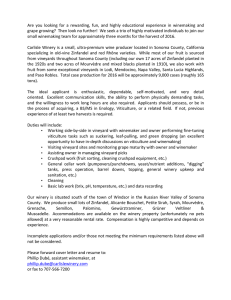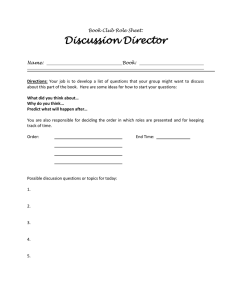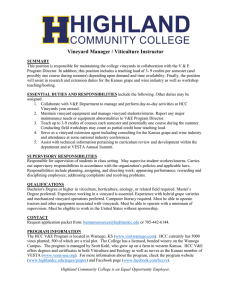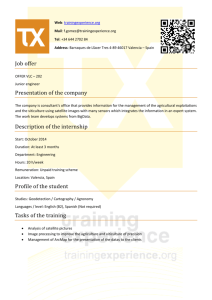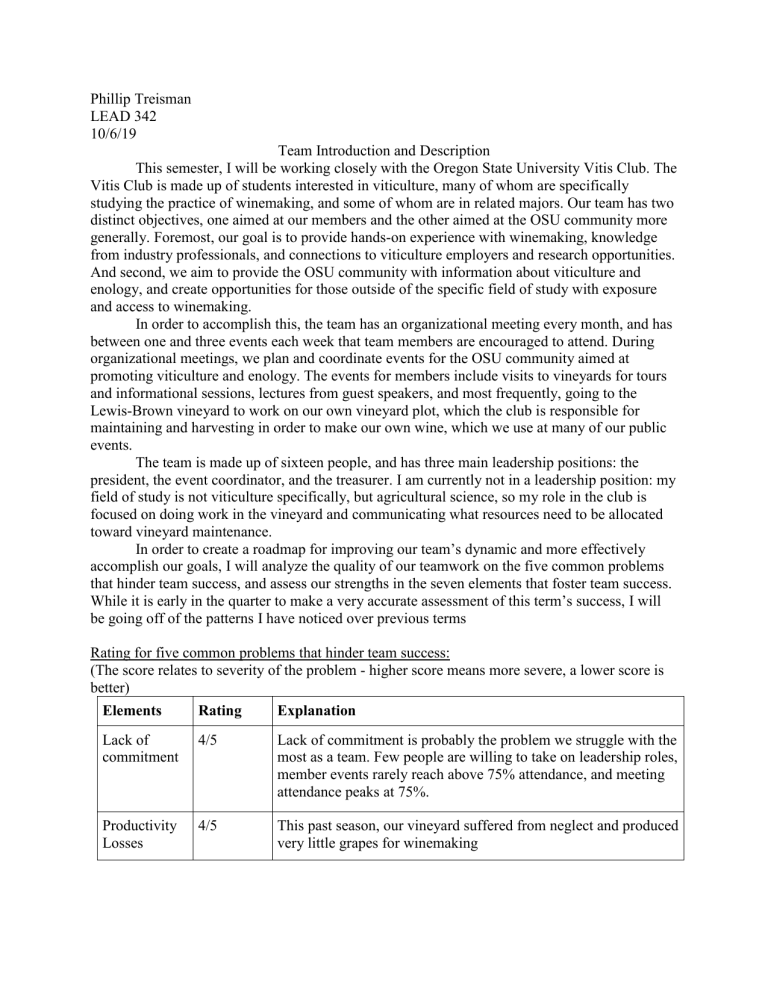
Phillip Treisman LEAD 342 10/6/19 Team Introduction and Description This semester, I will be working closely with the Oregon State University Vitis Club. The Vitis Club is made up of students interested in viticulture, many of whom are specifically studying the practice of winemaking, and some of whom are in related majors. Our team has two distinct objectives, one aimed at our members and the other aimed at the OSU community more generally. Foremost, our goal is to provide hands-on experience with winemaking, knowledge from industry professionals, and connections to viticulture employers and research opportunities. And second, we aim to provide the OSU community with information about viticulture and enology, and create opportunities for those outside of the specific field of study with exposure and access to winemaking. In order to accomplish this, the team has an organizational meeting every month, and has between one and three events each week that team members are encouraged to attend. During organizational meetings, we plan and coordinate events for the OSU community aimed at promoting viticulture and enology. The events for members include visits to vineyards for tours and informational sessions, lectures from guest speakers, and most frequently, going to the Lewis-Brown vineyard to work on our own vineyard plot, which the club is responsible for maintaining and harvesting in order to make our own wine, which we use at many of our public events. The team is made up of sixteen people, and has three main leadership positions: the president, the event coordinator, and the treasurer. I am currently not in a leadership position: my field of study is not viticulture specifically, but agricultural science, so my role in the club is focused on doing work in the vineyard and communicating what resources need to be allocated toward vineyard maintenance. In order to create a roadmap for improving our team’s dynamic and more effectively accomplish our goals, I will analyze the quality of our teamwork on the five common problems that hinder team success, and assess our strengths in the seven elements that foster team success. While it is early in the quarter to make a very accurate assessment of this term’s success, I will be going off of the patterns I have noticed over previous terms Rating for five common problems that hinder team success: (The score relates to severity of the problem - higher score means more severe, a lower score is better) Elements Rating Explanation Lack of commitment 4/5 Lack of commitment is probably the problem we struggle with the most as a team. Few people are willing to take on leadership roles, member events rarely reach above 75% attendance, and meeting attendance peaks at 75%. Productivity Losses 4/5 This past season, our vineyard suffered from neglect and produced very little grapes for winemaking Poor 2/5 Communicati on The president communicates infrequently with the entire group, however individual members maintain an effective and constant network of communication Interpersonal Conflict 0/5 Members get along well and really like each other, which makes our events appealing to attend Poor Leadership 1/5 Our leadership is committed and competent, however we need more people in leadership roles Rating for seven elements that foster team success: (The score relates to quality level of the element - higher score means better quality, a lower score is worse) Elements Rating Explanation Shared vision 5 Everyone in the club is interested in viticulture, and we all have shared ideas about horticultural sustainability and social responsibility Trust While trust is high among group members, we have many new members at this point in the term, and people struggle to trust people they haven’t known for that long. 3 Team Identity 5 As everyone in the club is interested in pursuing a career in growing, our shared identity is strong. Collective Efficacy 3 When working together, as a team we are very effective and can accomplish great things. Motivating individuals to actually do work can be tricky though, as demonstrated by our failure to adequately maintain our vineyard this past year. Participative Safety 4 Members are encouraged not only to express themselves and communicate their opinions, but also to physically participate in winemaking processes regardless of their skill level, and so far, events have had high participation rates (of those who attend). Task Orientation 3 The team has been able to break down our overall goals into concrete achievable tasks, and has found varied success in completing these tasks Support for Innovation 5 Since we are a club and have no revenue or production quotas to meet, our viticulture techniques are frequently experimental and we are eager to constantly try new ways of engaging with the community
